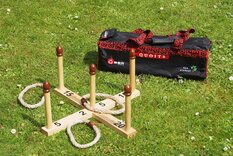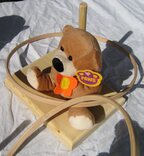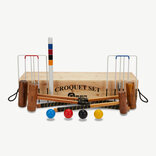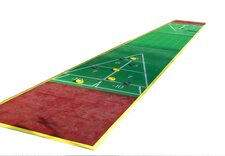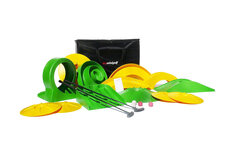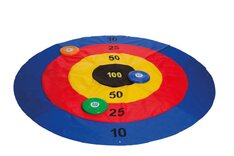The Rules of Outdoor Quoits
Steel quoits is a game probably derived from the ancient martial sport of Discus throwing. Being a traditional pub game without any national governing body, variations of equipment and rules abound. Where there is doubt, locally played rules should always apply. These rules are merely this author's interpretation of the most popular and traditional games being played today as follows:
- the venerable Long Game as played in Scotland and Wales,
- the East Anglian game now confined to tiny pockets around North Suffolk,
- the traditional Northern game played in the North of England.
- Slate bed quoits from Pennsylvania, USA,
- Deck Quoits born in the 1930s
- Sward Quoits included for people who wish to play Quoits informally in their garden or elsewhere outdoors.
See also: Quoits Games.
Quoits - The Long Game
The Long Game or The Old Game can still be found in Wales and Scotland. It seems to be most venerable of the Quoits games and the heaviness of the quoits, sheer distance and difficulty in seeing the pin make it both challenging to play and dramatic to watch. The Welsh version is given here. The Scottish game used to played at a range of 21 yards but these days is identical to the Welsh version bar a few minor differences - for instance the Welsh measure the distance to a quoit from the centre of the pin whereas the Scottish measure from the edge of the pin
Description
The pitch is 18 yards long with 3 feet square clay quoiting beds enclosed in a wooden frame. The clay descends 8" but the wooden frame is 2 inches wide and its depth is only 3 inches. The consistency of the clay is very important because a well thrown quoit should embed itself in the clay at an angle - the precise angle and orientation is often tactically crucial. Either side of the beds are "running boards" from which the players throw the quoits. These days they are often made from concrete. A player must throw from behind a line level with the pin marked on the boards. The centrally placed pin is 1 inch in diameter and 18 inches long but the top is flush with the clay. So the objective is not to try to ring the pin so much as to get as near to it as possible - it acts simply as a target more akin to bowls. The result of this is that the ideal shot is generally taken to be one that ends with the underside of the quoit touching the top of the pin. Such a quoit makes it very difficult for the opponent to land near to the target whereas a genuine ringer that circles the pin is beatable. The quoits are normally made of steel and should be no bigger than 8.63 inches and with a hole no less than 3.4" with no limit on the height or weight. A typical quoit will be 7 - 8" in diameter, have a hole diameter of 4.5 inches and weigh anything between 6 and 11 pounds. To assist the players, two helpers can be allocated to them. Firstly a "cleaner" can be tasked with cleaning the clay from quoits after each end. Cleaners are rarely employed these days - players tend to clean their own quoits. More vitally, each player has a helper called a "lighter". The lighter places a small piece of white paper within the bed before each throw for the player to aim at. Often this is on the pin itself, it being almost invisible in the clay at 18 yards but sometimes, the lighter will place the paper elsewhere within the bed according to the tactics of the throw. For instance, sometimes the objective might be to flip an opponent's quoit out of play. The lighter also provides the player with measurements, a description of the current state of play and tactical advice.
Play
The rules of play are very simple. A single game is played by two people and each person throws two quoits alternately each turn. The players then walk to the other hob and standing alongside it throw the quoits at the opposite hob. The player with the quoit nearest to the pin wins the end and scores two points if both quoits from that player are nearest to the pin or otherwise just one point. The game is won by the first player to reach 21 points.
In the annual international match played between Scotland and Wales, two teams of 12 players compete in seeded order. So each player plays once against the person ranked the same in the opposing team. The final result is made up of the aggregate scores of the teams.
Quoits - The East Anglian Game
Within England the Long Game does still exist but in a modified form as played mainly in North Suffolk. The game is played at the same distance but has a few differences as outlined below:
Description
The clay beds are circular and slope slightly towards the thrower with a 5/8 inches diameter hob (pin) flush with the clay. The quoits should be no greater than 7 1/4" in diameter and no heavier than 7 1/4 lb. in weight.
The Play
The concept of a "ringer" is given more credence in this version - any ringer scores 2 points and is removed from the bed prior to the next throw. So the maximum points that can be scored at one end is 4. Any quoit that lands on its back (a "woman"), or which lands inclining backwards does not count and is immediately removed. Any quoit outside or touching the 18" ring is also removed immediately.
Once all four quoits have been thrown, if no ringers have been scored, the player with the closest quoit scores one point or, where both quoits from the same player lie closest, scores two points. A "cover" (quoit that covers the pin) counts before a "side-toucher" and any quoit on top of a cover cannot count as a ringer. A league game is up to 33 points.
Quoits - The Northern Game
While the Long game is played in Wales and Scotland, the most popular Quoits game in England is a quite different prospect. Not only is the pitch significantly shorter and the quoits smaller and lighter but the difference in scoring results in a more tactical game.
Description
The pitch consists of two soft clay squares 3 feet square delineated by a wooden box, each of which has a hob (iron post) standing centrally 2 - 3 inches above the surface, the distance between the hobs being exactly 11 yards apart. A quoit is usually made of iron or steel and the blacksmith hammers it into a shape not dissimilar to the the bottom of a wine glass with a hole in the middle of it. The size and weight of quoits varies according to personal preference but they tend to be about five and a half inches across and about the same number of pounds in weight. The Northern rules stipulate that a quoit must be no more than 8 1/2" in diameter, no more than 1 1/4" in height, no more than 5lb 4oz in weight and the hole must be no more than 5 1/2" in diameter. A typical quoit weighs around 5 lbs and measures about 5 1/2" across. The top surface of the quoit is referred to as "the hill" while the concave underside surface is called the "the hole".
The Play
Due to the way the scoring works, the maximum score for each end is 2 points. The winner is the player who reaches the score of 21 first. In a pub match, two teams of 8 play and each member of a team is paired with an opponent. The total scores of both teams are added to decide victorious team.
A toss of a quoit decides who throws first. Instead of heads or tails, one player chooses hill side up, the other hole side up. After that, the privilege of the first throw alternates with the end. Two points are scored for a "ringer", a quoit which lands over the hob. If more than one quoit is a ringer, only the top one scores - this is a key point for skilful players as it means that tactically, it is not always good play to aim for a ringer. Instead, it may be better for the player who throws first to try to "cover" the top of the hob with a quoit stuck in the clay at an angle. If all four quoits miss the hob, a single point goes to the owner of the nearest quoit. A quoit which lands so that part of it is covering the top of the hob (a "cover") counts before a quoit which is touching the hob (a "side-toucher"). Callipers decide disputes.
Sward or Lawn Quoits
Because the clay pits required for official pitches are difficult to maintain and can be messy, a less serious version of the game is often played without them. In this, two iron stakes are stuck in a lawn at 11 or 18 yards apart, depending upon the region, and protruding slightly more than they would do above clay. The game is then played using the local rules as far as possible. Playing this way is obviously a more feasible prospect for people playing at home or at fairs but the game is still interesting and the condition of the ground can vary the playing tactics considerably.
To play informal quoits outdoors on a lawn, Masters Games recommends that the stakes are positioned 11 yards apart protruding 6 inches above the ground. The scoring should be done as per the Northern game: The top ringer scores 2 points and other ringers score nothing ; where there are no ringers, the nearest quoit scores 1 point.
Later, as a thought provoking exercise, try using the dimensions of the old Scottish Game - 21 yards with a hob flush to the ground. Your admiration for the old hands who could apparently repeatedly snuff out a candle without moving it from this range should be enormous!
Pennsylvanian Slate Bed Quoits
Quoits is undergoing a resurgence in some areas of the USA. The following game has become popular in Pennsylvania.
Equipment
Two slate boards 24 by 24 by 1 inch are used with a hole in the centre of each, into which is placed a hub (centrally placed pin). Grooved circles are visible bullseye fashion around each hub and underneath a 2 x 4 inch piece of wood is attached so that the boards sit at an angle. The boards are placed at ground level at a distance of 18 feet (6 yards) from hub to hub. Four hard rubber quoits are thrown.
Play
In a two player game, players "walk" from board to board at each turn. In a four player game there are two to a team and a pair of opponents stay at one board for the entire game. To avoid injury, players and spectators should stand well clear of the slate bed being targeted. A toss of a coin decides who begins. Players alternate - one throws one quoit and then the other player throws. 21 points wins the games.
Any quoit that touches the floor is considered "dead" and does not score. If a quoit hits the floor and then bounces disturbing quoits already on the slate, the dead quoit is removed and the other quoits are moved back to their positions before being disturbed. Experienced players often attempt to knock their opponent's quoits off the board leaving their quoits remaining which is called "digging". A quoit that finishes upside down counts. For such a simple game the scoring can seem complicated a player because a ringer cancels any opponents ringers underneath it. Hopefully the following serves to make this comprehensible:
If a player has scored the top two ringers, that player scores 6 points.
Otherwise, the player with the top ringer scores 3 points. If no other ringers were scored and the same player also has the nearest quoit, an extra 1 point is scored.
If there are no ringers, 2 points are scored if a player threw the nearest two quoits, otherwise 1 point is scored for the nearest quoit.
Deck Quoits
There are no set standards for Deck Quoits - partly because of its informal nature and partly because the game has to adapt to the shape and area of each particular ship it is played upon.
Equipment
The quoits are simply rope rings and each player would normally have either three or four of them. There are two "ends" each with a target which tends to be a mark on the deck referred to as a "jack". Around the jack concentric circles are marked. The areas between each circle are marked with their scoring amounts. The outer rings score less than the inner rings and the jack scores the highest - precise scores involved vary. The jack and rings are commonly made from brass sunk into the deck.
Play
The player who won the previous end throws first. Players toss a coin to decide who starts the first end and, in the event of a draw, the player who went first previously starts again. Players throw alternately at the jack with their front foot inside the innermost circle of the end being thrown from. In singles, players throw from alternate ends whereas for doubles one player from each side stands at either end so no walking between the ends is needed. After all quoits have been thrown, the winner of the end receives the points scored by any quoits nearer to the jack than the opponent's nearest quoit. A quoit touching a circle scores the points for the outer ring. A quoit that lies on top of another quoit, typically does not count. The first player or partnership to score 21 points, wins.
These rules are provided by Masters Traditional Games, an Internet shop selling quality traditional games, pub games and unusual games. For general information or for copying and copyright, see our Rules Information page.
Our rules are comprehensive instructions for friendly play. If in doubt, always abide by locally-played or house rules.
Copyright James Masters, 2025. All rights reserved.


